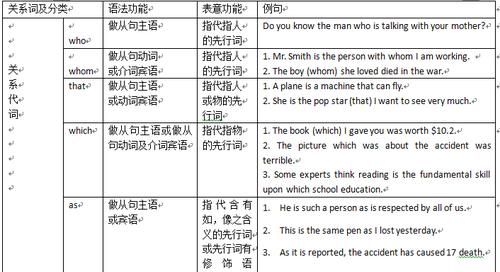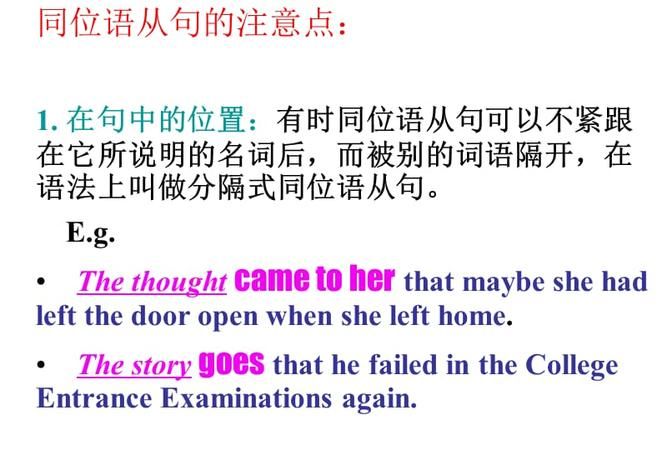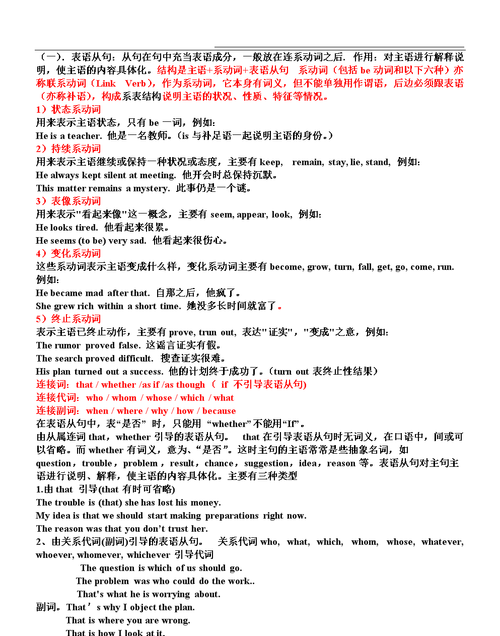本文目录
宾语从句表语从句同位语从句主语从句等名词性从句的语序还有引导词的搭配需要祥细过程
宾语从句
(1)对于宾语从句要掌握以下三点
①语序: 从句的语序必须是陈述句语序, 即“主语 + 谓语”这种形式。
②时态: 当主句是一般现在时或一般将来时的时候, 从句可以是任何时态, 而当主句是一般过去时的时候, 从句, 从句时态必须是过去时范围的时态, 即(一般过去时, 过去进行时, 过去完成时, 过去将来时)。
③连接词: 当从句意思完整, 主句意思肯定时, 连接词用that, 且可以省去, 当从句意思完整, 主句意思不确定或含否定含意时, 常用if或whether(是否), 当从句意思不完整时, 连接词则是代替不完整部分的特殊疑问词。
状语从句
(2)对于状语从句, 我们主要学习了时间状语从句和条件状语从句。对于这两种状语从句, 除了注意语序要用陈述句语序外, 在时态上尤其要注意, “主将从现”这种结构(即: 当主句是将来时态时候), 从句如果也要用将来时, 则必须用一般现在时代替一般将来时, 时间状语从句和条件状语从句的连接词通常为: when, while, as soon as, until和if。所以, 当连接词为以上五个词时, 如果主句是将来时, 就要考虑从句是否也要用将来时, 如果是, 则用“主将从现”结构, 其它还有由so…that…构成的结果状语从句, 由Though…或…but…, 构成的让步状语从句和由because或so构成的原因状语从句, 注意Though(虽然)与but(但是), because(因为)与so(所以)不能同时出现在句子里, 只用其中之一表达汉语中两个词的意义。
表语从句
在句子中起表语作用的从句叫做表语从句,位于主句系动词的后面。表语从句的引导词和主语从句的引导词相同。也是名词性从句的一种。
如:What What the police want to know is when you enred red the room警察想知道的是你什么时候进的房间。
The The trouble is that we are short of funds困难是我们缺乏资金。
This This is what we should do这是我们应当做的。
That”s s why I want you to work there那就是我要你在那儿工作的原因。
His His first question was whether Mr. Smith had arrived yet他的第一个问题是史密斯先生到了没有。
注意:从句中的疑问句用正常语序,即陈述语序。
as as if, as though, becau也可用来引导表语从句。
She She seems as if she had done a great thing她看起来好像做了一件大事。
It It is because you eat too much那是因为你吃得太多了。
同位语从句
一、在复合句中用作同位语的从句叫同位语从句。它一般跟在某些名词后面,用以说明该名词表示的具体内容。如:
I heard the news that our team had won.我听到了我们队获胜的消息。
I had no idea that you were here.我不知道你在这里。
二、可以跟同位语从句的名词通常有new,idea,fact,promise,question,doubt,thought,hope,message,suggestion,word(消息),possibility等。如:
I’ve come from Mr wang with a message that he won’t be able to see you this afternoon. 我从王先生那里来,他让我告诉你他今天下午不能来看你了。
三、英语中引导同位语从句的词通有连词 that,whether,连接副词 how,when,where等。(注:if,which 不能引导同位语从句。)如:
l have no idea When he will be back.我不知道他什么时候回来。
He must answer the question whether he agrees to if or not.
他必须回答他是否同意这样一个问题。
四、有时同位语从句可以不紧跟在说明的名词后面,而被别的词隔开。 如:
Several years later,word came that Napoleon himself was coming to inspect them.
几年以后,有消息传来说拿破仑要亲自视 察他们。
The thought came to him that maybe the enemy had fled the city.
他突然想起可能敌人已经逃出城了。
五、同位语从匈与定语从句的区别。
1、同位语从句与前面的名词是同位关系,即说明它前面名词的内容;而定语从句与前面的名词是修饰与被修饰关系,即限定它前面的名词范围,或补充一些情况。如:
The news that l hove passed the exam is true.我通过了考试这一消息是真的。
(同位语从句,即从句所表达的意思就是前面名词的内容。)
The news that he told me just now is true.他刚才告诉我的消息是真的。
(定语从句,从句对前面名词起修饰限制作用,即“他告诉我的”那个消息,而不是别的消息。)
2、引导同位语从句的that是连词,在从句中不充当任何成份,而引导定语从句的that是关系代词,除起连接作用外,还在从句中充当主语、宾语或表语等。如:
The idea that computers can recognize human voices surprises many people.
计算机能够识别人的声音的想法使许多人感到惊奇。(that在从句中不充当任何成份。)
The idea that he gave surprises many people.他提出的观点令许多人感到吃惊。
(that在从句中作gave的宾语。)
定语从句(很麻烦的说~)
定语从句(Attributive Clauses)在句中做定语,修饰一个名词或代词,被修饰的名词,词组或代词即先行词。定语从句通常出现在先行词之后,由关系词(关系代词或关系副词)引出。
关系代词有:who, whom, whose, that, which等。
关系副词有:when, where, why等。
1. 关系代词引导的定语从句
关系代词所代替的先行词是人或物的名词或代词,并在句中充当主语、宾语、定语等成分。关系代词在定语从句中作主语时,从句谓语动词的人称和数要和先行词保持一致。
1)who, whom, that
这些词代替的先行词是人的名词或代词,在从句中所起作用如下:
Is he the man who/that wants to see you?
他就是你想见的人吗?(who/that在从句中作主语)
He is the man whom/ that I saw yesterday.
他就是我昨天见的那个人。(whom/that在从句中作宾语)
2) Whose 用来指人或物,(只用作定语, 若指物,它还可以同of which互换), 例如:
They rushed over to help the man whose car had broken down. 那人车坏了,大家都跑过去帮忙。
Please pass me the book whose (of which) cover is green. 请递给我那本绿皮的书。
3)which, that
它们所代替的先行词是事物的名词或代词,在从句中可作主语、宾语等,例如:
A prosperity which / that had never been seen before appears in the countryside. 农村出现了前所未有的繁荣。(which / that在句中作宾语)
The package (which / that) you are carrying is about to come unwrapped. 你拿的包快散了。(which / that在句中作宾语)
2. 关系副词引导的定语从句
关系副词可代替的先行词是时间、地点或理由的名词,在从句中作状语。
1)when, where, why
关系副词when, where, why的含义相当于"介词+ which"结构,因此常常和"介词+ which"结构交替使用,例如:
There are occasions when (on which) one must yield. 任何人都有不得不屈服的时候。
Beijing is the place where (in which) I was born. 北京是我的出生地。
Is this the reason why (for which) he refused our offer? 这就是他拒绝我们帮助他的理由吗?
2)that代替关系副词
that可以用于表示时间、地点、方式、理由的名词后取代when, where, why和"介词+ which"引导的定语从句,在口语中that常被省略,例如:
His father died the year (that / when / in which) he was born. 他父亲在他出生那年逝世了。
He is unlikely to find the place (that / where / in which) he lived forty years ago. 他不大可能找到他四十年前居住过的地方。
3 .判断关系代词与关系副词
方法一: 用关系代词,还是关系副词完全取决于从句中的谓语动词。及物动词后面无宾语,就必须要求用关系代词;而不及物动词则要求用关系副词。例如:
This is the mountain village where I stayed last year.
I'll never forget the days when I worked together with you.
判断改错(注:先显示题,再显示答案,横线;用不同的颜色表示出。)
(错) This is the mountain village where I visited last year.
(错) I will never forget the days when I spent in the countryside.
(对) This is the mountain village (which) I visited last year.
(对) I'll never forget the days (which) I spent in the countryside.
习惯上总把表地点或时间的名词与关系副词 where, when联系在一起。此两题错在关系词的误用上。
方法二: 准确判断先行词在定语从句中的成分(主、谓、宾、定、状),也能正确选择出关系代词/关系副词。
例1. Is this museum ___ you visited a few days age?
A. where B. that C. on which D. the one
例2. Is this the museum ____ the exhibition was held.
A. where B. that C. on which D. the one
答案:例1 D,例2 A
例1变为肯定句: This museum is ___ you visited a few days ago.
例2变为肯定句: This is the museum ___ the exhibition was held.
在句1中,所缺部分为宾语,而where, that, on which都不能起到宾语的作用,只有the one既做了主句的表语,又可做从句的宾语,可以省略关系代词,所以应选D。
而句2中, 主、谓、宾俱全,从句部分为句子的状语表地点,既可用副词where,又因 in the museum词组,可用介词in + which 引导地点状语。而此题中,介词on 用的不对,所以选A。
关系词的选择依据在从句中所做的成分,先行词在从句中做主、定、宾语时,选择关系代词 (who, whom, that, which, whose); 先行词在从句中做状语时,应选择关系副词 ( where 地点状语,when 时间状语,why 原因状语)

英语主句和从句的时态关系
可以存在主句是一般过去时,从句是现在完成时的情况的。原因如下:当从句表示客观事物或真理,或人们已经公认的道理时,其时态不受主句谓语动词的时态的影响。即使主句谓语动词使用了过去时的某种时态,从句的时态仍然是现在的某种时态。当然一般情况下,主句是一般过去时,从句一般也应该是过去时态的。
一、在宾语从句中主句和从句之间的时态的一致关系,通常由主句谓语的时态决定从句谓语的时态。
⒈若主句谓语动词是现在时或将来时,如:一般现在时,现在完成时,一般将来时,将来完成时等,从句可以根据需要使用任何时态。
⒉若主句谓语动词是过去时态(一般过去时,过去进行时,过去完成时,过去将来时,过去将来完成时),从句谓语动词也必须是过去时态。
⑴如果从句动作与主句动作同时发生,从句用一般过去时或过去进行时。
⑵当从句动作发生在主句动作之前,从句要用过去完成时。
⑶当从句动作发生在主句动作之后,从句要用过去将来时。
⒊当从句表示客观事物或真理,或人们已经公认的道理时,其时态不受主句谓语动词的时态的影响。即使主句谓语动词使用了过去时的某种时态,从句的时态仍然是现在的某种时态。
⒋当从句表示并未出现或尚未实现的愿望时,必须用过去时态。
⒌有些形容词后面可跟有从句,这种从句一般可看作宾语从句,其谓语也应与主句谓语的时态保持一致。可跟这种宾语从句的形容词有:afraid, glad, sure, confident, sorry, certain, conscious, aware等。一致的原则与宾语从句相同。
例如:
I'm confident that I'll pass the exam. 我有信心通过考试。
He was lucky that he wasn't killed. 他很幸运没有被杀死。
二、在主语从句,表语从句和同位语从句中,主句和从句之间的时态一致关系所遵守的法则和宾语从句相同。
例如:
It appears that some little trouble was caused by a woman, whose name has not been ascertained. 看来这件小小的麻烦是由一个至今尚不清楚其姓名的女人所引起的。
It was known long ago that Professor Einstein played a key role in the development of the theory of relativity. 人们早已知道,爱因斯坦教授对相对论的发展起了关键作用。
It was proved centuries ago that the speed of light is 186,000 miles a second. 几世纪前就证实了光的速度为每秒186,000英里。
The fact that man would soon be able to visit the moon built up new scientific interest in earth's nearest neighbor. 人类不久可以游览月球的事实,引起了对地球最近邻居的新的科学兴趣。
三、定语从句与主句的时态一致关系
⒈若定语从句的谓语表示的动作和主句谓语表示的动作同时发生,则要求使用同样的时态。
例如:
The original manuscript of "The Theory of Relativity" was written by Einstein who was then an employee in a patent office. “相对论”的原稿是由当时在一家专利办公室工作的爱因斯坦写的。
⒉主句与定语从句的谓语表示的动作如果不是同时发生,时态则不要求一致。
例如:
Have you seen the new golf clubs that Mr. Stevens gave Bill? 你看过史蒂文斯先生给比尔的那些新高尔夫球棒了吗?
I painted several pictures that are now on show in the museums. 我画了几张画,现在正在博物馆里展出。
四、状语从句与主句的时态一致关系
⒈如果状语从句的谓语表示的动作和主句谓语表示的动作同时发生,则要求使用同样的时态。
例如:
Immanuel Kant was so regular in his habits that until the day he died people were able to set their watches by his actions. 伊迈努尔·康德的习惯那么有规律,以至直到他死以前人们都能按他的行动来对表。
When Abraham Lincoln became President of the United States of America, he was completely involved in the problem of slavery.当亚伯拉罕·林肯成为美国总统时,他便陷入到奴隶问题的漩涡中去了。
⒉由when, while, as引起的进行时,若主句表示的动作比从句表示的动作更引人注目,主句用过去时(或现在时),从句用过去进行时或现在进行时)。若两个动作同样注目,可以都使用进行时。
例如:
As I was walking along Main Street, a car mounted the pavement and crashed into a shop. 当我正沿着大街走时,一辆汽车越过人行道,冲进一家店铺里去了。
While the child was playing with his toys, his parents were reading books. 孩子在玩玩具,他父母在看书。
When I was returning home from school, a parade of demonstrators walked along the streets. 当我从学校回家时,一队游行示威者从街上走过。
⒊如果状语从句的谓语表示的动作和主句谓语表示的动作不是同时发生,则要使用相应的时态。
注意:使用after与before连接的状语从句之间的区别在于:
●使用after时,从句用完成时;使用before时,主句用完成时。
●因为after与before两个连词本身已表示动作有先后,所以由这两个连词引起的状语从句也可以使用与主句一样的时态。
例如:
The director had explained the details many times before the workers took the job. 工头在工人们开始工作前把细节给他们讲了好多遍。
Each of the major glacial stages produces distinctive land forms that remain long after the glacier has disappeared. 每一主要冰河期都产生特殊的地形,这种地形一直保留到冰川消失之后很久。
He did not know any English before he went to England. 在去英国以前,他一点儿英语都不懂。
After she finished her work, she hurried to the nursery to pick up her child. 干完工作后,她匆匆赶到托儿所接孩子。

同位语从句前后时态要一致吗
这个是同位语从句,时态要根据前面修饰的那个名词内容来定。这里很显然,答案不是很合适,同位语从句的主语不应该是he,应该是the documents,从句应为:the documents needed in the product meeting for further discussion.

英语语法 同位语从句宾语从句主语从句表语从句的具体区别要各带例句的
同位语,宾语,主语和表语从句都使名词性从句以下为区别.
主语从句
主语从句(Subject Clause)
主语从句 定义:在句子中担当主语的是一个从句,这个从句就叫做主语从句.
主语从句是在复合句中充当主语的从句,通常放在主句谓语动词之前或由形式主语it代替,而本身放在句子末尾.
1. It 作形式主语和it引导强调句的比较
It 作形式主语代替主语从句,主要是为了平衡句子结构,主语从句的连接词没有变化.而it引导的强调句则是对句子某一部分进行强调,无论强调的是什么成分,都可用连词that.被强调部分指人是也可用who/whom.例如:
It is a pity that you didn’t go to see the film.
2. 用it 作形式主语的结构
(1) It is +名词+从句
It is a fact that … 事实是…
It is an honor that …非常荣幸
It is common knowledge that …是常识
(2) it is +形容词+从句
It is natural that… 很自然…
It is strange that… 奇怪的是…
(3) it +不及物动词+从句
It seems that… 似乎…
It happened that… 碰巧…
(4) it is+过去分词+从句
It is reported that… 据报道…
It has been proved that… 已证实…
3. 主语从句不可位于句首的五种情况
(1) if 引导的主语从句不可居于复合句句首.
(2) It is said , (reported) …结构中的主语从句不可提前.例如:
It is said that President Jingo will visit our school next week.
(3) It happens…, It occurs… 结构中的主语从句不可提前.例如:
It occurred to him that he failed in the examination.
(4) It doesn’t matter how/whether …结构中的主语从句不可提前.例如:
It doesn’t matter whether he is wrong or not.
(5) 含主语从句的复合句是疑问句时,主语从句不可提前.例如:
Is it likely that it will rain in the evening?
4. What 与that 在引导主语从句时的区别
What 引导主语从句时在从句中充当句子成分,如主语.宾语.表语,而that 则不然.例如:
What you said yesterday is right.
二:宾语从句的几个特征:1、引导词:what\which\whose\when\whether\if\where
2语序:宾语从句必须是用陈述语句.
如:I think that you must work harder.
宾语从句的引导词、连接词的区别、否定转移等现象.
(1)表达时间的几个句型:一般用when或者是what time:
What time will the train leave?
由于时刻都是固定的,也可以用一般现在时代替一般将来时:
What time does the train leave?
(2)时间的表达方式:8:19(nineteen past eight),7:57(three to eight),在时间的中间也可以加上分的单词(minutes)
(3)had better +动词原型.意思是提要求,建议.但是上下级不能用这种方式,因为语气太重:
You had better give up smoking .
(4)sb leave sth +地点
I left my book in my classroom yesterday.
(5)may I have your name(address\age)?一般询问对方的年龄、名字等,不要习惯以前的问法,这样很不礼貌,而是要采访上面的问法.以前的习惯是:how old are you? \what's your name?
(6)修饰名词的代词次序:限-描-大-形---年---颜----籍----物--------类+名词:
this is a bridge.
This is a beautiful bridge
表语从句
表语从句
一 定义:
A 表语从句就是用一个句子作为表语.说明主语是什么或者怎么[1]样,由名词、形容词或相当于名词或形容词的词或短语充当,和连系动词一起构成谓语.
The problem is puzzling.
这问题令人困惑
主语 连系动词 形容词作表语
The problem is when we can get a pay rise.
问题是,当我们可以得到加薪.
主语 连系动词 一个句子作表语---表语从句
B 连接表语从句的连接词有:that, what, who, when, where, which, why,
whether,how.
He has become a teacher.
他已经成为一名教师.
He has become what he wanted to be ten years ago.
他已经成为了他10年前想成为的.
She has remained there for an hour.
她曾在那里停留了一个小时.
She has remained where I stood yesterday for an hour.
她一直在我昨天站的地方站了一个小时.
His suggestion is good.
他的建议是好的.
His suggestion is that we should stay calm.
他的建议是,我们应该保持冷静.
The question is confusing.
这个问题令人困惑.
The question is when he can arrive at the hotel.
问题是,他什么时候可以到达酒店.
who will travel with me to Beijing tomorrow.谁与我明天将前往北京.
why he cried yesterday.
昨天他为什么哭.
how I can persuade her to join us in the party.
我怎么能说服她加入我们的派对.
whether the enemy is marching towards us.
是否敌人正向我们行进.
二 注意:
A 表语从句一定要用陈述语序.
False: The question is when can he arrive at the hotel.
Right: The question is when he can arrive at the hotel.
B 不可以用if,而用whether 连接表语从句(as if 例外).
引导宾语从句时可以互换if/whether 位于介词后要用whether
位于句首时要用whether
引导表语从句,主语从句,同位语从句时要用whether
False: The question is if the enemy is marching towards us.
Right: The question is whether the enemy is marching towards us.
Right: It looked as if he had understood this question.
C 不像宾语从句,在有表语从句的复合句中,主句时态和从句时态可以不一致.
Right: The question is who will travel with me to Beijing tomorrow.
Right: The question is why he cried yesterday.
D that在表语从句中不可以省掉.
表语从句的基本用法
表语从句只能置于主句之后,而主句的动词只能是联系动词.
名词性从句在be等系动词后作表语时被称为表语从句, 例如: The problem is how we can get the things we need.问题是我们怎样能弄到我们需要的东西.(how 在表语从句中充当方式状语)// The scissors are not what I need. 这把剪刀不是我所需要的.(what 在表语从句中充当宾语)// What I told him was that I would find him a good play. 我告诉他的是我会给他找个好剧本.(what在主语从句中作直接宾语, that作为表语从句的引导词在该表语从句中不充当句子成分, 不能省略)// That is what I want to tell you.那就是我想要对你讲的.(what在表语从句中充当直接宾语)// That is why she failed to pass the exam. 那就是她考试不及格的原因.(why 在表语从句中充当原因状语)
注意: “That is why...”是常用句型, 意为“这就是……的原因/因此……”, 其中why引导的名词性从句在句中作表语, 该句型通常用于针对前面已经说明过的原因进行总结, 又如: That is why you see this old woman before you know, Jeanne. 珍妮, 这就是现在这个老太婆出现在你面前的原因.(前文提到Jeanne对老妇人显得苍老憔悴深感诧异, 说话人对她讲述了其中的原因之后,用这一句来进行概括).// That is why I came. 这就是我来的原因.
下面是两个与“That is why...”形式相似的结构, 它们与“That is why...”结构之间的关系要能够辨析清楚:
(1)“That is why...”与“That is the reason why...”同义, 只不过从语法结构上讲, “That is the reason why...”中why引导的是—个定语从句, 将其中的the reason去掉则与“That is why...”结构一样, 例如:
That is (the reason) why I cannot agree. 这就是我不能同意的理由.
(2)“That is because...”句型中从属连词because引导的名词性从句在此作表语, 这也是个常用句型, 意为“这就是为什么……/因为……”.“That is because...”与“That is why...”之间的不同在于“That is because...”指原因或理由, “That is why...”则指由于各种原因所造成的后果, 例如:
He did not see the film last night. That is because he had to help his little sister with her homework.昨天晚上他没有去看电影, 那是因为他得帮助他的妹妹做作业.(第一句话说明结果, 第二句话说明原因)
He had seen the film before. That is why he did not see it last night.他以前曾看过那部电影, 因此他昨天晚上没有去看.(第一句话说明原因, 第二句话说明结果)
同位语从句
一、在复合句中用作同位语的从句叫同位语从句.它一般跟在某些名词后面,用以说明该名词表示的具体内容.如:
I heard the news that our team had won.我听到了我们队获胜的消息.
I had no idea that you were here.我不知道你在这里.
二、可以跟同位语从句的名词通常有news,idea,fact,promise,question,doubt,thought,hope,message,suggestion,words(消息),possibility等.如:
I’ve come from Mr wang with a message that he won’t be able to see you this afternoon. 我从王先生那里来,他让我告诉你他今天下午不能来看你了.
三、英语中引导同位语从句的词通有连词 that,whether,连接副词 how,when,where等.(注:if,which 不能引导同位语从句.)如:
l have no idea when he will be back.我不知道他什么时候回来.
He must answer the question whether he agrees to it or not.
他必须回答他是否同意这样一个问题.
四、有时同位语从句可以不紧跟在说明的名词后面,而被别的词隔开. 如:
Several years later,word came that Napoleon himself was coming to inspect them.
几年以后,有消息传来说拿破仑要亲自视 察他们.
The thought came to him that maybe the enemy had fled the city.
他突然想起可能敌人已经逃出城了.
五、同位语从句与定语从句的区别.
1、同位语从句与前面的名词是同位关系,即说明它前面名词的内容;而定语从句与前面的名词是修饰与被修饰关系,即限定它前面的名词范围,或补充一些情况.如:
The news that l have passed the exam is true.我通过了考试这一消息是真的.
(同位语从句,即从句所表达的意思就是前面名词的内容.)
The news that he told me just now is true.他刚才告诉我的消息是真的.
(定语从句,从句对前面名词起修饰限制作用,即“他告诉我的”那个消息,而不是别的消息.)
2、关系词在句中是否做成分 .如:
The idea that computers can recognize human voices surprises many people.
计算机能够识别人的声音的想法使许多人感到惊奇.(that在从句中不充当任何成份.)
The idea that he gave surprises many people.他提出的观点令许多人感到吃惊.
(that在从句中作gave的宾语.)
3、从句是否有疑问的意义.如:
eg.Do you remember the day when i told you that i loved you?(when引导的从句不表示疑问,所以这是一个定语从句.)
eg.I have asked the question why it was true just now.(why引导的从句表示疑问,所以这是一个同位语从句.)
一个名词(或其它形式)对另一个名词或代词进行修饰,限定或说明,这个名词(或其它形
式)就是同位语.同位语与被它限定的词的格要一致,并常常紧挨在一起.
宾语从句
学习宾语从句要抓住三要素:连接词、语序和时态.
1.连接词
连接词一般都是that(指事务或人),which(指事),who(指人)
1.从句为陈述句,常选择连接词that或将that省略,直接与主句相连.
2.从句为一般疑问句,常选择连接词if或whether.在 whether … or not 结构中不能用 if 替换.
3.从句为特殊疑问句,常选择what,when,where,which,who,how等的疑问代、副词作连接词.
注意:当who为主语时,句式为:who+谓语+其他
2.判断时态情况:
1.主句是一般现在时,从句为各种时态情况.
2.主句是一般过去时,从句为各种相应过去时态注意:从句描绘客观事实,用一般现在时.
eg:
1. The teacher told the children that the sun____ round.
A. was B. is C. were D. are
2. I believe that our team____ the basketball match.
A. win B. won C. will win D. wins
3. I don’t know____ to visit the old man.
A. whether B. if C. that D. who
4.The soldiers soon reached( )was once an old temple( )the villagers used as a school.
A.which;where B.what;which C.where;which D.what;where
答:选B,动词reach后接宾语从句,从句缺少宾语,where不可,which引导宾语从句时表疑问含义“哪一个…”而此句中并非疑问含义,不知道哪一座庙宇,而是用what从句表陈述含义,意“过去的一座旧庙宇”;temple后为对其修饰的定语从句,用关系代词which代替,并在从句中作动词used的宾语,use sth. as…“把…用作…
宾语从句用作宾语.如:
Do you know where he lives?
定语从句相当于一个形容词,用于修饰前面的名词.如:
The student who answered the question was John. 回答问题的学生是John.
This is the man whom he is looking for.
Do you know the girl who is in red?
语法~~~~~~~~~~~~~~~~~~~~~~~~~~~~~~~~~~~~~~~~~~~~~~~~~~~~~~~~~~~~~~~
宾语从句的用法
1.that引导宾语从句无意义,不充当句子成分常省略.但下列情况除外:
(1)介词宾语从句的that不省略
(2) and连接的几个从句,第二个从句以后的从句的that不省略.
He told me that he had two sons and that they both had gone to college.
(3)在动词+it+宾语补足语+宾语从句结构中,that不省略.
I heard it said that he had gone abroad
We found it impossible that he could finish it in such a short time
2.Whether ,if 引导宾语从句:两词可互换,但是下列情形除外:
(1)whether从句中有or not
(2)whether从句做介词宾语
Everything depends on whether you agree with us
3.许多带复合宾语的句子,宾语从句经常移到句子后部,而用it做形式宾语.结构常是:
主语+动词+it+形容词/名词等宾语补足语+宾语从句
We think it wrong that he told a lie to everyone
4.宾语从句的语序要用陈述句语序
False: He is wondering when can he finish this difficult job.
Right: He is wondering when he can finish this difficult job.
B 有时候可以用it 作形式宾语

以上就是关于同位语从句主句和从句时态 ,同位语从句的前后时态问题的全部内容,以及同位语从句主句和从句时态 的相关内容,希望能够帮到您。
